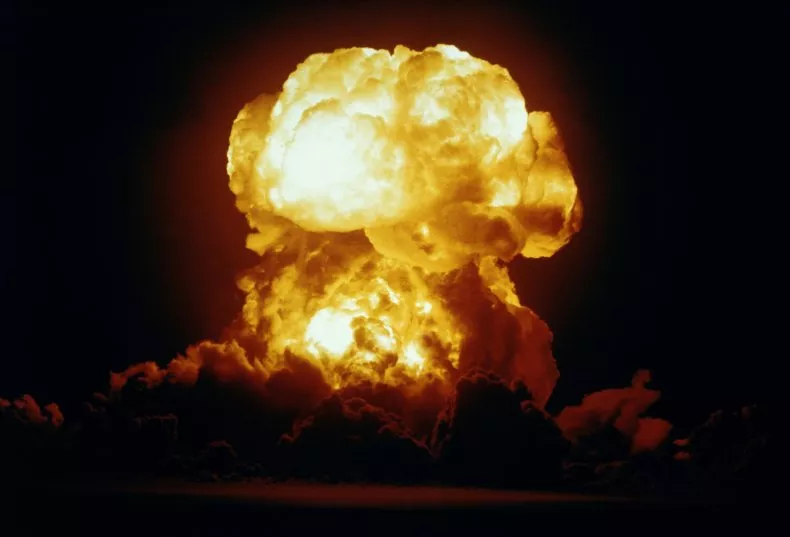Conflicts between the West and Russia soared after President Vladimir Putin started his attack on Ukraine in February, and they deteriorated as the Western began supporting Ukrainian troops with badly needed military supplies.
While it is unclear if Russian President Vladimir Putin might use nuclear weapons, despite frequent threats to deploy them, as per Science Times, the development of the Ukraine crisis has raised concerns about the onset of a nuclear war.
A nuclear war emulator developer has stated that understanding the threat presented by nuclear warheads is "critical."
Recently, Science Times reported the possible impact if, hypothetically, all nuclear weapons explode simultaneously. Following the International Campaign to Abolish Nuclear Weapons (ICAN), nuclear weapons are the most destructive, brutal, and indiscriminate weapons ever produced. They are also more persistent in probable radioactive harm than other weapons.
A single nuclear weapon may be detonated over a huge metropolis and annihilate millions of people within its radius. Deploying thousands of such bombs would destabilize the global climate, resulting in severe hunger.
Nuclear Impact Simulation
Christopher Minson, a research scientist who developed a program to evaluate the consequences of a nuclear bomb assault on the United States, informed Newsweek that the fighting in Ukraine had resulted in a "huge surge in traffic" to his website. Minson said that, in reality, the site has evolved into a proxy gauge for tensions between the two countries.
He also observed a significant increase in popularity and said that something's happened to make the globe more concerned; conversely, when traffic settles down, he comprehends that people are in a pretty tranquil time with no news. Minson stated that he designed the application as a civil administration to educate the population about the devastating effects of nuclear war, as he described in his statement.

Stock image showing a U.S. Navy nuclear test at Bikini Atoll, Marshall Islands. The NUKEMAP simulator shows what would happen if a nuclear bomb detonated near you.
ALSO READ: Russia Might Have Deployed Its Nuclear Weapon Poseidon; How Does It Work?
Minson's Gathered Nuclear Data
According to the Stockholm International Peace Research Institute, there are around 13,000 nuclear weapons in the hands of Russia or the United States today.
These nuclear weapons rarely came and went and instead expanded throughout the globe, as Minson claimed. But the risk of those being utilized grows each year as arsenal grows and our world gets more unstable.
He then stated that it is vital that the public grasp this threat; people need to realize, plainly and viscerally, exactly how widespread and deadly a nuclear war might be. On Minson's webpage, there is an application that simulates a large-scale nuclear strike in the United States. The said simulator depicts what would transpire if approximately 1,200 warheads-roughly 7% of the world's stockpile-were to strike the United States.
As per Minson, this is a probable explanation based on empirical facts and established targeting tactics, albeit an assault in real life may take numerous shapes. Visitors may use the visualization feature to observe the two-hour attack unfold, with nuclear warheads destroying several military and political facilities and civilian areas. Each second in the simulation model is comparable to one minute in actual life.
Minson built the simulator using a collection of US targets gathered from leaked material, together with a database of warhead yields. He then created a second dataset of demographic data, connecting the inhabitants to desired locations.
Basis of the Simulator
Based on well-known thermodynamics, the simulation model depicts the impacts of nuclear explosions on the surface. It also stimulates the dispersion of nuclear debris, the nuclear waste that remains in the planet's troposphere after a nuclear catastrophe. Nonetheless, Minson claims that all these estimates are more difficult and sensitive to a plethora of factors, such as land earth science and direction of development, weapon size, explosion height, and seasons, including weather forecast and wind velocities.
Minson added that there's also the issue of interactions when numerous missiles impact the same target because it is a tough topic, but the US military has researched it. He highlighted that the scenarios displayed in the emulator are simply an estimate of what might occur throughout a nuclear assault, mostly in the United States. Minson has added a second tool on the web page to map the impact of one nuclear weapon on a single target in the U.s.
NUKEMAP, designed by Alex Wellerstein, a nuclear weapons historian and assistant professor at Stevens Institute of Technology in Hoboken, New Jersey, is another simulator software tool that models the consequences of a nuclear detonation or full nuclear war. It also includes the four-minute audiovisual work "Plan A," created by scholars affiliated with Princeton University's Program on Science and Global Security.
RELATED ARTICLE: Possible Impact of Explosion of All Nuclear Weapons; Here's the Scientific Explanation!
Check out more news and information on Energy and Physics in Science Times.














